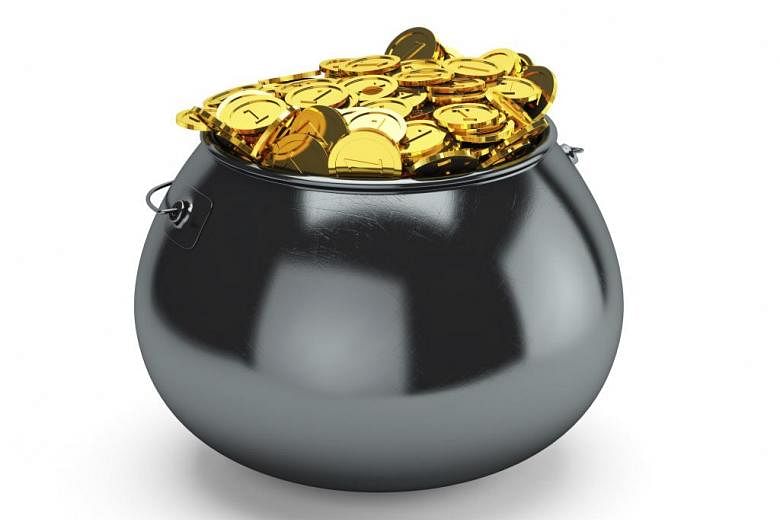Tailor portfolio to risk appetite
What would you do if you had an extra $20,000, $50,000 or even $100,000 sitting in the bank?
You could leave it there to collect meagre interest, or splurge on an
exotic holiday trip and lots of new gadgets. Our suggestion is to make your money work hard, and various experts offer some tips that you can mix and match according to your risk appetite.
Mr Marc Lansonneur, DBS Bank's head of investment products in Singapore, says: "Investment strategies should be based on some key guidelines that apply to any investment in general."
Take some of his advice for a start: Define your investment objectives, the time horizon of different types of investments, aim for your overall savings to yield at least as much as the inflation rate, assess your risk profile and do your homework. Mr Lansonneur adds: "Singapore's inflation forecast for 2016 is around 1.3 per cent - so that would be the minimum yield you should target to achieve for your overall savings to prevent its value from eroding."
Mr Dennis Khoo, UOB's head of personal financial services in Singapore, says investors should always adopt an investment strategy they are comfortable with.
"A younger individual can afford to take on more risk in their investments because they have time on their side, while an older individual may choose to be more risk-averse." He notes that when it comes to investing, investors should follow the general principles of diversification, dividend investing, compounding and time.
WITH $20,000
At this stage, you could very well be new to investing, saving for a few years and are looking to grow that amount in the near future.
Mr Khoo takes the example of an investor with a moderate risk appetite, a 20-year time horizon and seeking a 5 per cent investment return.
-
HOW TO INVEST
-
WITH $20,000 - 100 % Unit trusts
WITH $50,000 - 40% Stocks And 60 % Unit trusts
WITH $100,000 - 60% Stocks, 30 % Fixed income assets And 10 % Real estate investment trusts
He says: "For a $20,000 investment, it can be strategic to invest 100 per cent of the sum into unit trusts and reinvest any distributions (payouts), thus accumulating compound interest over time.
"The investor should avoid spreading the small investment sum over a large number of stocks as dealing costs would be too high."
He adds that this way, the investor has the benefit of being invested in a diversified portfolio and getting the specialists to manage the investment - stock and asset selection - and risks or volatility.
Mr Lansonneur says that many investment products - unit trusts, retail bonds, single shares or fixed deposits - are available to beginner or novice investors who start with $20,000 in capital.
"They should start using simple products such as unit trusts to access these asset classes before choosing for themselves individual shares or bonds," he adds.
"Unit trusts are flexible and well-adapted tools to populate investment portfolios. They provide the expertise of a fund manager, diversification - investors can access balanced funds that combine bonds and equities - liquidity and, in some cases, income distribution."
He says that exchange-traded funds (ETFs) are also becoming more popular as they let investors put money in various asset classes and indices.
Mr David Mok, IPP's investment and research head, suggests that a regional unit trust or an ETF that covers a broad geographical area reduces country-specific or firm-specific risks.
He brings up a point about no-vice investors putting all their funds into blue-chip stocks.
"Blue-chip stocks are known for their stability but it can still be risky if an investor does not diversify," he says. For example, you could have invested in a blue chip like Sembcorp Marine. From last August to this month, the share price fell about 32 per cent because of the plunge in oil prices, he notes, adding: "Such risk can be mitigated through diversification, and an effective way to go about it is through unit trusts or ETFs."
He also notes that many Singaporeans invest only in the local stock market, which means they neglect opportunities in foreign markets which have decent returns.
The S&P 500 index, for instance, had a one-year return of 6.5 per cent, while the Nikkei Index's one-year return was 32.48 per cent as at last Monday, says Mr Mok, citing Bloomberg data.
WITH $50,000
Unit trusts still emerge a top choice among experts for a $50,000 cash pile.
Mr Gregory Choy, OCBC Bank's wealth advisory head, explains: "The advantage of investing in unit trusts is that it allows investors to participate in the market with a smaller investment outlay and still be able to have a well-diversified investment, as opposed to investing into direct equities, which generally requires a higher outlay." He suggests that novice investors look into global balanced funds or multi-asset funds.
Such funds usually invest in a good mix of global diversified assets, which in turn helps investors manage market risk effectively.
At this stage, Mr Khoo says, you can afford to allocate a greater proportion to stocks as long as your cash needs are met.
Consider allocating 40 per cent to stocks and 60 per cent to unit trusts, for instance. Mr Mok suggests having five funds, up from three funds if you have only $20,000. These could be regional funds that are globally diversified.
He adds that a larger investment amount would benefit more from diversification.
Mr Mok also points out: "Equity is favoured over bonds for young investors who have a very long investment horizon as they will be able to ride through any volatility in the market.
"On the other hand, bonds are favoured over equity for retirees who do not want excess volatility in their retirement portfolios."
WITH $100,000
Mr Khoo says it could be time to look at an allocation across stocks at 60 per cent, fixed income assets at 30 per cent, and real estate investment trusts at 10 per cent. "Such a diverse portfolio can help reduce market risks and generate steady returns in the long term."
He also thinks that a cost-effective way to achieve portfolio diversification is through global multi-asset mutual funds.
Mr Choy adds that you could look to adding some other asset classes to enhance investment returns on top of unit trusts.
If you do not already have ETFs, consider adding them to the mix, and stocks.
"However, they should keep such investments at no more than 20 to 30 per cent of their investment funds, as single-stock investments do carry a higher level of concentrated risk, which might present volatility more than what the investor could withstand," says Mr Choy, adding that the remaining 70 to 80 per cent of your investment funds should be invested through unit trusts to form the core portfolio.
GENERAL TIPS
Regardless of how much you have, you can also tailor your portfolio according to your risk appetite.
Mr Lansonneur says a low-risk portfolio could have 42 per cent of the total investment amount in fixed-income products such as bonds, 28 per cent in equities and 30 per cent in cash.
For a medium risk portfolio, put 29 per cent in fixed income, 56 per cent in equities, 12 per cent in cash and 3 per cent in alternative investments such as gold.
He suggests people with a high-risk appetite should have 4 per cent in fixed income, 89 per cent in equities, 7 per cent in alternatives and none in cash.
"The riskier the product, the more work you will need to do in learning about its upsides and downsides," says Mr Lansonneur, stressing that you have to understand the products you wish to invest in.
He adds: "For cash investments, investors can choose to place their deposits in principal-guaranteed accounts such as fixed deposits or high-yielding cash accounts."
One helpful resource for those seeking to construct their personal portfolios is DBS Model Portfo-lios (www.dbs.com.sg/treasures-private-client/investments/de-fault.page), which are dynamic asset allocation models that are regularly updated.
You have to review your own investment portfolio regularly as well, says Mr Mok, and do it quarterly or every six months, and rebalance it when needed.
He notes: "While model portfo-lios are important in helping investors diversify within their risk tolerances, there is solid evidence that active asset allocation, as opposed to staying in a static portfolio, tremendously enhances returns during troubled times - which means going defensive in terms of asset allocation."
Mr Choy reminds investors that achieving a higher return entails undertaking a higher level of risk.
"A novice investor should understand his risk appetite in order to understand what return he should expect," he advises.
"The investor should work with his financial adviser to develop the investment plan to achieve the appropriate level of return according to the investor's risk appetite."


